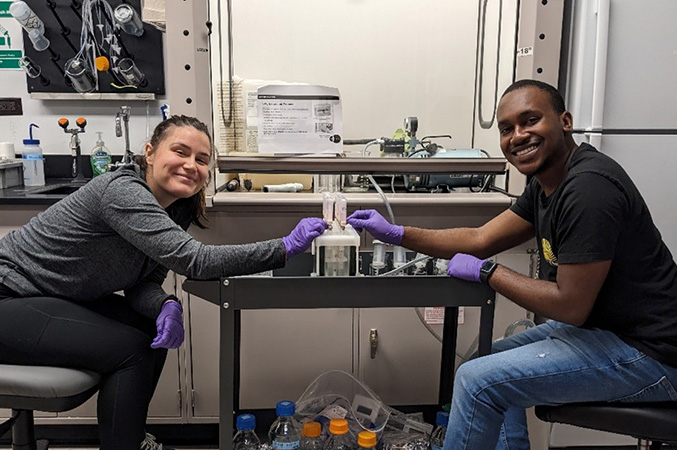Drinking Water Tested for Forever Chemicals in Response to Community Concerns
In response to community concerns about per- and polyfluoroalkyl substances (PFAS) contamination, researchers and community engagement professionals from the NIEHS Superfund Research Program at North Carolina State University (NC State) worked with nonprofit organizations in North Carolina’s Cape Fear River Basin to test drinking water samples for PFAS. PFAS are a group of man-made chemicals that are discharged into air and water during industrial manufacturing processes. PFAS linger in the environment and do not break down over time, earning them the name “forever chemicals.” North Carolina’s Cape Fear River Basin is home to a variety of industries that have contributed to PFAS levels in ground and surface water over the years.
A May 2024 paper describes the process the researchers used for sample collection, analysis, and data dissemination.
Many rivers are a source of drinking water and used for recreation. If contaminated with PFAS, both river uses can be a route of exposure. (Photo courtesy of Wijs (Wise) of Pexels)
Engaging Community Members to Collect Water Samples
PFAS exposure has been linked to adverse health effects including developmental delays in children, increased cholesterol levels, decreased fertility, and increased risk of some cancers. Previous research has found elevated levels of PFAS in blood samples from residents throughout the entire Cape Fear River basin. There is ongoing awareness of and concern about PFAS among North Carolina residents who get drinking water from the river or access it for recreational activities.
“The partnership with NCSU through this sampling has provided essential information to our impacted community members about the safety of their drinking water,” stated Emily Sutton, the Haw Riverkeeper with the Haw River Assembly, a community partner on this study. “Unfortunately, the Haw and Cape Fear watersheds are still plagued with contamination from industrial polluters of these toxic PFAS chemicals and the access to additional resources for sampling has allowed our organizations to give support to these families and hold the polluters accountable.”
The NC State Center for Environmental and Health Effects of PFAS worked with three environmental nonprofits that serve residents throughout the Cape Fear River basin. Researchers provided each group with a sampling protocol and collection materials, and each organization identified and collected samples in their area. Together, the groups collected samples near Pittsboro, Fayetteville, and Wilmington, representing the upper, middle, and lower areas of the river basin, respectively.
The groups collected 45 water samples. About half the drinking water samples were from municipal water, with the rest from wells. Three samples were from recreational water. Many of the water sources had not previously been tested for PFAS.
PFAS Traced to Local Industries
Due to the proximity and known PFAS emissions by local industries, community members expressed concern about a particular subset of PFAS. The research team, therefore, aimed to test the samples for these specific chemicals. Additionally, the team wanted to know whether other PFAS were present and conducted an untargeted analysis for a variety of PFAS types.

Lacey Brown, a co-researcher on the project, works with an undergraduate student in the lab to extract PFAS from water samples. (Photo courtesy of Rebecca Weed)
Results indicated that almost half the samples had PFAS levels over the Environmental Protection Agency’s (EPA) maximum contaminant level of 4 nanograms per Liter (ng/L) which the EPA has established to protect from excess exposure that may harmful to human health. Nineteen samples tested over the limit for one common type of PFAS, while 21 samples tested over the limit for another common type. Further, the three recreational water samples had an average PFAS level of 49.37 ng/L. PFAS types were distributed uniquely across the three regions of the river, indicating that while each community faces elevated PFAS exposures, the type of PFAS varies by local sources of contamination.
The untargeted analysis found nine less common types of PFAS. Most of these have been developed more recently than more commonly reported legacy PFAS types and can be traced to products such as nonstick coatings, herbicides, pesticides, and components of lithium-ion batteries.
“In addition to providing quantitative results of commonly surveyed PFAS, we were proud to be able to capitalize on our cutting-edge mass spectrometry platforms at our center’s core facility to provide a non-targeted PFAS analysis,” added Weed. “This is an important and growing area of PFAS research as we endeavor to fully understand the extent and breadth of PFAS contamination in our local communities.”
The community engagement core and research translation team met with researchers and community partners to summarize and visualize the data, and each organization disseminated results to residents. The results ultimately helped empower residents to reduce their PFAS exposure by identifying drinking water sources with elevated levels of PFAS. With similar data from a growing body of work documenting PFAS in the Cape Fear River, community members have been advocating for large scale remediation and exposure protection. This study adds to these efforts.
Source link
www.niehs.nih.gov


